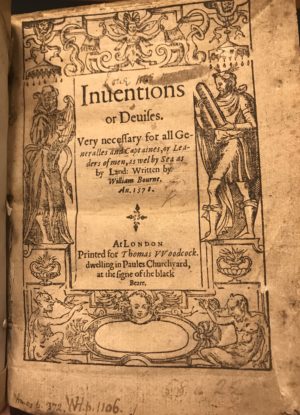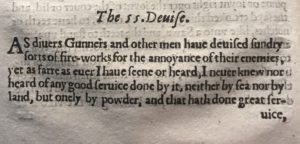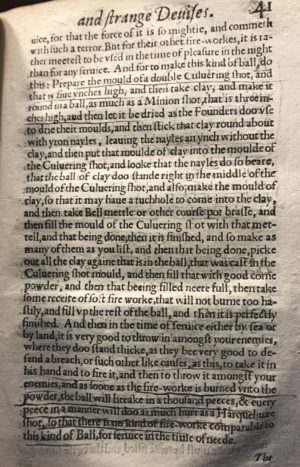I have been hinting that I had found an early printed book containing interesting matters with regards to ordnance, military engineering and explosives. Having worked initially from second-hand reports of the publication and an original manuscript version (a digital copy) which I couldn’t read at all, I finally tracked a printed copy down and literally got my hands on it, in the British Library, last week and so it’s time to start discussions of it.
The book is “Inventions or Devices” by William Bourne, or to give it it’s full title as it appears in the British Library catalogue ” Inuentions or Deuices, Very necessary for all Generalles and Captaines, or Leaders of men as well by Sea as by Land”, written and printed (I think) in 1578. Here’s the cover page:

Bourne appears to have been a well-travelled Naval gunner and mathematician with experience in of wars in Europe. The book is an odd list and description of military ideas and “inventions”, mostly practical or pragmatic. Some are startlingly obvious but others are quite fascinating and a little bit obscure. On one level he offers advice that a modern munitions specialist or ordnance officer would recognise in terms of “proofing” and inspection of ordnance. These ideas include safely unloading a fully loaded breech-fast projectile stuck in a cannon, methods of checking the barrel of cannons and a device for consistently assessing the power of a sample of gunpowder with a mechanical testing device. Other matters include various naval matters and the sapping and mining of castle walls, counter-mining and the design of assault ladders.
I’ll go through a number of these in future posts because the ideas are worth exploring and this is a very early publication, I think, for some of the technical ideas discussed. For now though, to start us off, here’s his description of a large grenade-like device. I’m going to post a couple of images of the actual pages then attempt to translate some of the archaic language. This is the earliest description I can find in a primary source about the design, manufacture and use of a metal cased grenade. The method describes using a mould for a 5″ cannonball to make a hollow grenade by using a clay insert in the casting. The case of the “grenade” is bell metal or brass, with iron nails providing the spacing to the void (and adding to fragmentation) which is filled with good quality gunpowder and a fuse.


Here’s my attempt at a translation:
The 55th Device.
As diverse Gunners and other men devised sundry sorts of fireworks for the annoyance of their enemies, yet as far as ever I have seen or heard, I never knew nor heard of any good service done by it, neither by sea nor by land, but only by powder, and that hath done great service, for that the force of it is mighty and commeth with such a terror. But for their other fireworks, it is rather meetest to be used in the time of pleasure in the night then for any service. And for to make this kind of ball, do this: Prepare the mould of a double culvering shot (a sort of cannonball) that is five inches high, and then take clay, and make it round in a ball, as much as a minion shot (another smaller size of cannon ball) that is three inches, and let it be dried as the Founders (Those who work in a foundry) do use to dry their moulds, and then stick that clay round about with iron nails, leaving the nails an inch without the clay, and then put that mould of clay into the moulde of the culvering shot, and look that the nails do bear that the ball of clay do stand right in the middle of the mould of the culvering shot, and also make the mould of clay so that it may have a touchhole to come into the clay, and then take bell metal or other coarse pot brass, and then fill the mould of the culvering shot with that metal, and that being done, then it is finished and so make as many as them as you list, and then that being done pick out the clay again that is in the ball, that was cast in the culvering shot mould and then fill that with good corne powder (good quality gunpowder), and then that being filled near full, then take some receite (? fuze?) of soft firework that will not burn too hastily and fill up the rest of the ball, and then it is perfectly finished. And then in the time of service, either by sea or by land, it is very good to throw in amongst your enemies, where they do stand thick, as they be very good to defend a breach or such other like causes, as this, to take it in his hand and to fire it, and then throw it amongst your enemies, and as soon as the firework is burned into the powder, the ball will break in a thousand pieces and every piece in a manner will do as much as an Arquebus shot (a bullet) so that there is no kind of firework comparable to this kind of ball, for service in the time of need.
This publication predates the adoption of such things (grenades) by armies several decades later in the 17th Century.
More of Bournes “Devices and Inventions” will follow in later blog posts.

Bourne is also creditted as inventor of a submersible craft. His original manuscript does not have an image or reference to it as far as I can read but I cannot locate a printed copy of his book to confirm or deny this and the BL copy is not available online. Do you have a copy confirming this underwater vessel (with a hollow mast apparently for ventilation) please and what devise number is it? Please feel free to email me. Thank you.
Author
Andrew, the underwater vessel is the 18th Devise. I have photos of the pages describing it, and there are no accompanying images. I’ll send you the images.
There is a blog about submarines which shows an image of the underwater vessel that is credited to Bourne, at
https://ahistoryofsubmarines.com/blogs/book-william-bournes-on-inventions-or-devices-1578/
There is also a ‘semi’ useful site which does include quite a few pages of Bournes work which includes most of his devices at https://quod.lib.umich.edu/e/eebogroup/
just search for William Bourne and there are 3 books of his which have been uploaded but the site has literally transcribed the text so you have to apply your own translations.
Roger, sorry to see your work come to an end, but fully understand the need to prioritise other tasks. Have enjoyed it all and followed up many of your leads. JB